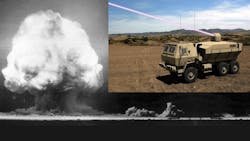I’ve always found the notion of “humane weapons” somewhat, well, counterintuitive, to say the least. It’s not a new idea, of course. There have long been efforts to devise weaponry intended to minimize what’s euphemistically referred to as “collateral damage,” i.e., casualties and/or property destruction beyond that of a weapon’s primary target. Even rubber bullets used for crowd control or tactical anti-riot scenarios can be thought of in this way. Although if you ask anyone who’s been on the receiving end of a rubber bullet, they might not agree with their characterization as “humane.”
The advent in the late 19th century of automatic weapons, such as the Gatling gun (1862) and Hiram Maxim’s machine gun (1885), which could fire up to 500 rounds per minute, so horrified pacifists of the time that the Hague Peace Conference of 1899 sought to tame such instruments by limiting rates of fire. That same Hague conference also addressed chemical weapons by prohibiting use of “poisons and poisoned arms.” Somehow, no one got the memo during the First World War, when both sides were spreading chlorine gas over battlefields, inflicting some 1.3 million casualties that may have included as many as 260,000 non-combatants.
The deployment of atomic weapons by the U.S. in Japan during WW2 led to the late 1950s/early 1960s concept of enhanced radiation weapons, which came to be known colloquially as “neutron bombs.” These low-yield thermonuclear devices are meant to maximize lethal neutron radiation near the blast while minimizing the blast’s city-flattening power. Such weapons were around until the fierce opposition of the anti-nuclear movement brought about their demise in the early 1990s.
In this edition of Defense Electronics, Technical Contributor Jack Browne takes us through the status of directed-energy weapons (DEWs), the latest efforts at “humane weapons.” Relying on high-energy lasers or electromagnetic waves, DEWs are beginning to show signs of moving out of the experimental realm and into practical, even portable, field deployment. They’re even being tested as defenses against yet another recent attempt at a more humane weapons systems—UAVs or drones. Perhaps DEWs, with their improvements in targeting and overall reduction in broad destructive power, can finally be the humane weapon that the 1899 Hague Peace Conference would have approved.
About the Author
David Maliniak
Executive Editor, Microwaves & RF
I am Executive Editor of Microwaves & RF, an all-digital publication that broadly covers all aspects of wireless communications. More particularly, we're keeping a close eye on technologies in the consumer-oriented 5G, 6G, IoT, M2M, and V2X markets, in which much of the wireless market's growth will occur in this decade and beyond. I work with a great team of editors to provide engineers, developers, and technical managers with interesting and useful articles and videos on a regular basis. Check out our free newsletters to see the latest content.
You can send press releases for new products for possible coverage on the website. I am also interested in receiving contributed articles for publishing on our website. Use our contributor's packet, in which you'll find an article template and lots more useful information on how to properly prepare content for us, and send to me along with a signed release form.
About me:
In his long career in the B2B electronics-industry media, David Maliniak has held editorial roles as both generalist and specialist. As Components Editor and, later, as Editor in Chief of EE Product News, David gained breadth of experience in covering the industry at large. In serving as EDA/Test and Measurement Technology Editor at Electronic Design, he developed deep insight into those complex areas of technology. Most recently, David worked in technical marketing communications at Teledyne LeCroy, leaving to rejoin the EOEM B2B publishing world in January 2020. David earned a B.A. in journalism at New York University.

